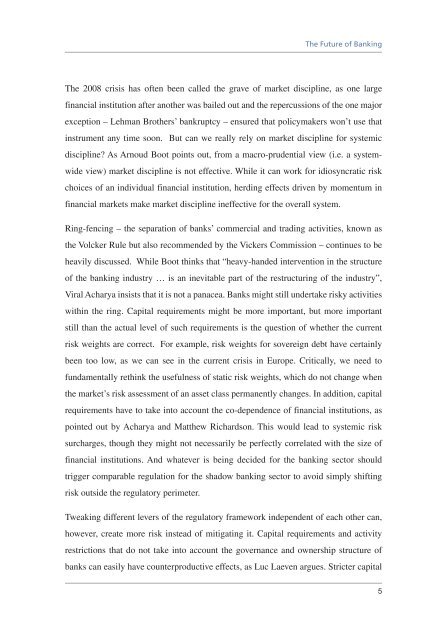You also want an ePaper? Increase the reach of your titles
YUMPU automatically turns print PDFs into web optimized ePapers that Google loves.
The Future of Banking<br />
The 2008 crisis has often been called the grave of market discipline, as one large<br />
financial institution after another was bailed out and the repercussions of the one major<br />
exception – Lehman Brothers’ bankruptcy – ensured that policymakers won’t use that<br />
instrument any time soon. But can we really rely on market discipline for systemic<br />
discipline? As Arnoud Boot points out, from a macro-prudential view (i.e. a systemwide<br />
view) market discipline is not effective. While it can work for idiosyncratic risk<br />
choices of an individual financial institution, herding effects driven <strong>by</strong> momentum in<br />
financial markets make market discipline ineffective for the overall system.<br />
Ring-fencing – the separation of banks’ commercial and trading activities, known as<br />
the Volcker Rule but also recommended <strong>by</strong> the Vickers Commission – continues to be<br />
heavily discussed. While Boot thinks that “heavy-handed intervention in the structure<br />
of the banking industry … is an inevitable part of the restructuring of the industry”,<br />
Viral Acharya insists that it is not a panacea. Banks might still undertake risky activities<br />
within the ring. Capital requirements might be more important, but more important<br />
still than the actual level of such requirements is the question of whether the current<br />
risk weights are correct. For example, risk weights for sovereign debt have certainly<br />
been too low, as we can see in the current crisis in Europe. Critically, we need to<br />
fundamentally rethink the usefulness of static risk weights, which do not change when<br />
the market’s risk assessment of an asset class permanently changes. In addition, capital<br />
requirements have to take into account the co-dependence of financial institutions, as<br />
pointed out <strong>by</strong> Acharya and Matthew Richardson. This would lead to systemic risk<br />
surcharges, though they might not necessarily be perfectly correlated with the size of<br />
financial institutions. And whatever is being decided for the banking sector should<br />
trigger comparable regulation for the shadow banking sector to avoid simply shifting<br />
risk outside the regulatory perimeter.<br />
Tweaking different levers of the regulatory framework independent of each other can,<br />
however, create more risk instead of mitigating it. Capital requirements and activity<br />
restrictions that do not take into account the governance and ownership structure of<br />
banks can easily have counterproductive effects, as Luc Laeven argues. Stricter capital<br />
5














